#Olympian Hiawatha Train
Text
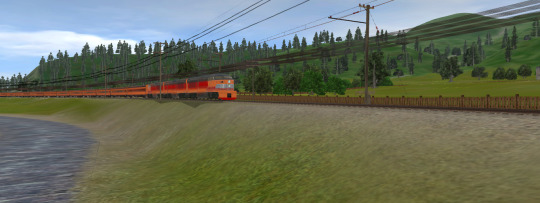
It’s a lazy Summer day as an A-B-A Set of Milwaukee Road Erie-Built diesels lead train No. 15, the Westbound Olympian Hiawatha, to Seattle, Washington. The train is making its way through Montana along the St. Regis River and a ranch where a group of horses munch on the grass and watch the train thunder by.
Models and Route by: Trainz, Auran, and Download Station
#Milwaukee Road#The Milwaukee Road#Chicago Milwaukee St. Paul & Pacific#Chicago Milwaukee St. Paul & Pacific Railroad#CMStP&P#Hiawatha#Olympian Hiawatha#Olympian Hiawatha Train#FM#Fairbanks-Morse#Erie-Built#FM Erie-Built#Diesel Locomotive#Trainz Simulator#Trains
1 note
·
View note
Photo

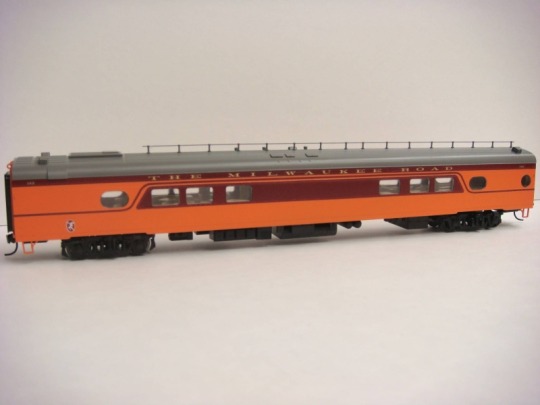



Milwaukee Road “Olympian Hiawatha” 1947 “Spaghetti Stripe” paint scheme designed by Brooks Stevens.
Photos:
1: Stevens’ original 1940s concept art for the Skytop lounge observation cars, which he also designed, featuring the paint scheme before their debut. Source
2–4: A model of a Hiawatha car with 1947 paint scheme. Source
5: Pair of Milwaukee Road cars preserved and refurbished in 1947 scheme. Source
14 notes
·
View notes
Text

Today was a successful day! I've been dreaming of getting the Olympian Hiawatha from Katy for literally years (I think I first thought of it 2016 or 2017?), but it was always hard to justify. It's cheap per car, but not cheap in total, and I already have several Kato american train packages (Super Chief and Broadway Limited), and at well over a meter long each, they're not actually all that practical. But they are cool. Anyway, one of the german importers for Kato had sets of this at basically every train show, and it seems they finally wanted to get rid of them, so they were now heavily discounted: 100€ for the full nine-car set with display tracks. Well, that was not a hard decision.
I don't have the right locomotives yet, they didn't have those there. My options right now are to buy the FP7s from Kato, or wait until someone makes the Bipolars or Little Joes in N scale, maybe, eventually, some day. I do know one store in Germany that still has a very limited number of the FP7s in stock unless their website is lying. If I go that route, do I need an A-B-A set or is A-B enough? …do I want an A-B-A set? Will I put Digitrax decoders in them or solder myself? The last one's actually easy, soldering in normal decoders is easy enough, cheaper, and in my experience it works better.
19 notes
·
View notes
Video
Milwaukee Road EP-2 class Bipolar E-4 por Craig Garver
Por Flickr:
Milwaukee Road EP-2 class Bipolar E-4 at Harlowton, Montana, October 8, 1958. This unit has just cut off from Train 16, the Olympian Hiawatha. Scanned from 5x7 photographic print owned by Digital Rail Artist.
9 notes
·
View notes
Text
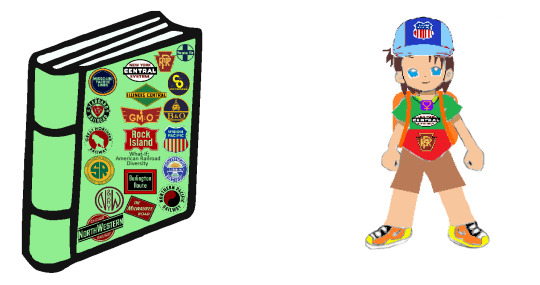
Here's a picture I made for @zponds. This is another one of Zachery’s key items; a green book titled “What-If?: American Railroad Diversity”. He wrote this whole book himself, and it explains what would have happened if President Dwight D. Eisenhower passed some laws and acts that allowed the railroads in America to innovate and fairly compete against cars and planes… as well as a Staggers Act of 1955 that severely deregulated the industry, making the ICC (Interstate Commerce Commissions) to not be a severe hindrance and villain to the railroads. Large class 1 railroads (like the New York Central) would have greatly benefited from this, but smaller railroads (like the Boston and Maine) wouldn’t be as lucky. But the smaller railroads’ lines would not go to waste as the much bigger ones would absorb the small ones. Not to mention that with many massive class 1 American railroads still around, competition would be healthy and we’d still see the paint schemes of the railroads and great passenger trains like the 20th Century Limited, Broadway Limited, Golden Spike Limited, Olympian Hiawatha, Mainstreeter, Empire Builder, the Zephyrs, etc.
2 notes
·
View notes
Text
What-If: American Railroads — Section 3: Named Passenger Trains and Streamliners
With the 20 American railroads still around and Amtrak not being a thing in my alternative history on American railroads, that means that the 20 railroads will still own and operate passenger services and streamliners, and some will operate some passenger trains and passenger train route legs from the smaller railroads absorbed by the bigger ones. And the names of the passenger trains and streamliners are below.
A. New York Central
20th Century Limited
Empire State Express
Pacemaker Express
The Mercury
Berkshire Hills Express
Southwestern Limited (NYCS train)
Twilight Limited
The Colonial
Bar Harbor Express
Cape Codder
Comet
East Wind
Dan’l Webster
Flying Yankee
Ohio State Limited
B. Pennsylvania Railroad
Broadway Limited
Liberty Limited
Trail Blazer Express
Federal Express
Congressional Limited
Maple Leaf
Black Diamond
Asa Packer
Crusader
The Admiral
Cincinnati Limited
The Keystone
Birmingham Special (PRR side)
Southland (PRR side)
Spirit of St. Louis
C. Chesapeake and Ohio
George Washington
Fast Flying Virginian
Sportsman
Pere Marquette
The Chessie
Atlantic Express
Pacific Express
Erie Limited
Lake Cities
Phoebe Snow
D. Baltimore and Ohio
Cincinnatian
Capitol Limited
National Limited
Blue Bird
Wabash Cannon Ball
City of St. Louis
Columbian
Royal Blue
E. Union Pacific
Challenger (UP side)
City of Denver
City of Portland
City of San Francisco
City of Los Angeles
Overland Limited (UP side)
Exposition Flyer (UP side)
Forty-Niner Express
Butte Special
City of Las Vegas
Los Angeles Limited
F. Chicago and Northwestern
The 400’s — Twin Cities 400, Dakota 400. Flambeau 400, Kate Shelley 400, Minnesota 400, Peninsula 400, Rochester 400, Shoreland 400 and Capital 400
City of San Francisco
City of Los Angeles
Overland Limited (CNW side)
G. Milwaukee Road
The Hiawathas — Twin Cities Hiawatha, Midwest Hiawatha, North Woods Hiawatha, Chippewa Hiawatha and Olympian Hiawatha
City of Denver
City of Portland
Pioneer limited
Challenger (MILW side)
Varity
H. Burlington Route
The Zephyrs — Twin Cities Zephyr, Pioneer Zephyr, Texas Zephyr, Nebraska Zephyr, Mark Twain Zephyr, Denver Zephyr, Kansas City Zephyr, Silver Streak Zephyr, American Royal Zephyr and General Pershing Zephyr
Zephyr Rocket (CB&Q side)
Sam Houston Zephyr (CB&Q side)
Black Hawk
California Zephyr (CB&Q side)
New Orleans Zephyr
I. Missouri Pacific
Colorado Eagle
Texas Eagle
Valley Eagle
Sunshine Special
Firefly
Meteor
J. Northern Pacific
North Coast Limited
Mainstreeter
Coast Pool Train
Great Western Limited
Omaha Express
Mills Cities Limited
K. Great Northern
Empire Builder
Cascadian
Oriental Limited
Red River Limited
Western Star
Winnipeg Limited
L. Norfolk and Western
Pocahontas
Powhatan Arrow
Tennessean (N&W side)
The Cavalier
Birmingham Special (N&W side)
M. Southern Pacific
Coast Daylight
City of San Francisco
Sacramento Daylight
Shasta Daylight
Sunbeam
Golden State (SP side)
Challenger (SP side)
Argonaut
Sunset Limited (SP side)
Overland Limited (SP side)
N. Santa Fe
Chief
Super Chief
San Francisco Chief
El Capitan
San Diegan
Texas Chief
West Texas Express
Chicagoan
Kansas Cityan
Grand Canyon Limited
O. Illinois Central
City of Miami (IC side)
Panama Limited
Green Diamond
Land O’Corn
Seminole Limited (IC side)
Southwestern Limited (IC train)
Lone Star
Morning Star
P. Gulf Mobile and Ohio
Gulf Coast Rebel
Gulf Coast Special
Alton Limited
Rebel
Midnight Special
Q. Rock Island
The Rockets — Choctaw Rocket, Des Moines Rocket, Quad Cities Rocket, Rock Island Rocket, Twin Star Rocket, Golden Rocket and Rocky Mountain Rocket
Sam Houston Zephyr (CRIP side)
Zephyr Rocket (CRIP side)
Golden State (CRIP side)
R. Southern Railway (USA)
Tennessean (SOU side)
Southener
City of Memphis
Birmingham Special (SOU side)
Carolina Special
Royal Palm
Piedmont Limited
Ponce de Leon
S. Seaboard Air Line
Silver Comet
Silver Meteor
Gulf Wind
Orange Blossom Special
Man O’War
Nancy Hanks (II)
City of Miami (SAL side)
Sunset Limited (SAL side)
T. Atlantic Coast Line
Champion
Florida Special
Palmetto (ACL side)
Dixie Flagler
South Wind (ACL side)
Southland (ACL side)
#history#passenger train#passenger trains#new york central#pennsylvania railroad#chesapeake and ohio#baltimore & ohio#union pacific#chicago & north western#milwaukee road#burlington route#missouri pacific#northern pacific#great northern#norfolk and western#southern pacific#santa fe#illinois central#gulf mobile & ohio#rock island railroad#southern railway#seaboard air line#atlantic coast line#alternate history#streamliner
1 note
·
View note
Text
Coeur d’Alene Loop (Day 1)
Wallace to Avery ID
28 September 2022
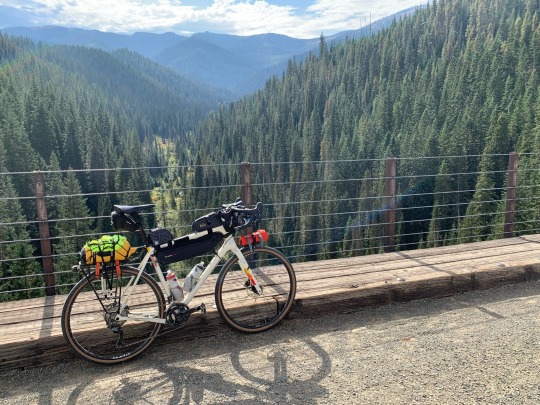
The next few posts describe a three-day ride this past week in northern Idaho. I’d wanted to do this loop for several years but just hadn’t found the right time. The high areas aren’t really accessible until June and our summers fill up with other plans. Early fall makes sense, but not if forest fires lead to smoky conditions. This year, family plans and weather and smoke seemed to align, so I drove to Wallace* on Tuesday, rode for three days, and made it home Friday night. The only hitch was the rain on Day 2!
The ride is billed by the Friends of the Coeur d’Alene Trails as the Bitterroot 300. It links together a series of trails and bike routes in a big loop in the northern Idaho panhandle. For me, the 50-70 mile a day distances and a good gravel bike made it perfect. For someone on a different bike or someone uncomfortable with the daily mileages (much of the first two days on gravel), it might not work as well. Three days allows for lodging, whereas taking more time (or less) might be easier with camping gear.
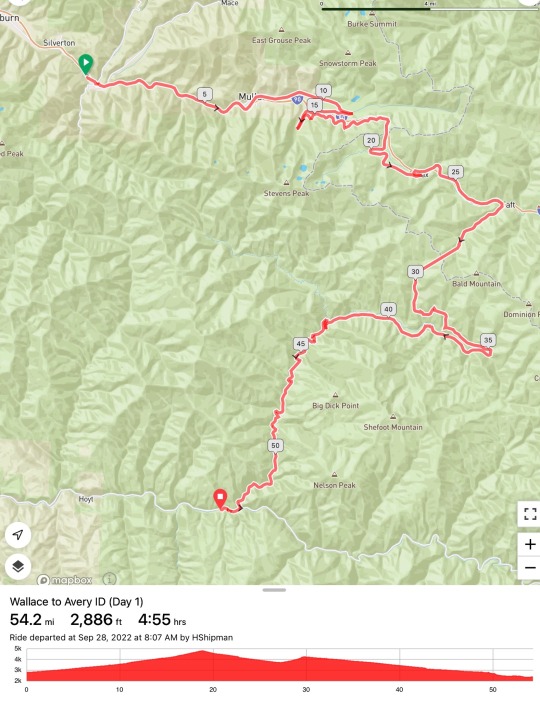
I began and ended my ride in Wallace* but that was certainly not the only option. I chose to do the trip without camping gear, as I was able to reserve rooms at each of my two intermediate stops (Avery and St. Maries). Wallace is near the eastern end of the Trail of the Coeur d’Alenes and my first 8 miles was to its eastern terminus in Mullan (I’ll ride the western 60 miles of the trail back to Wallace on Day 3).
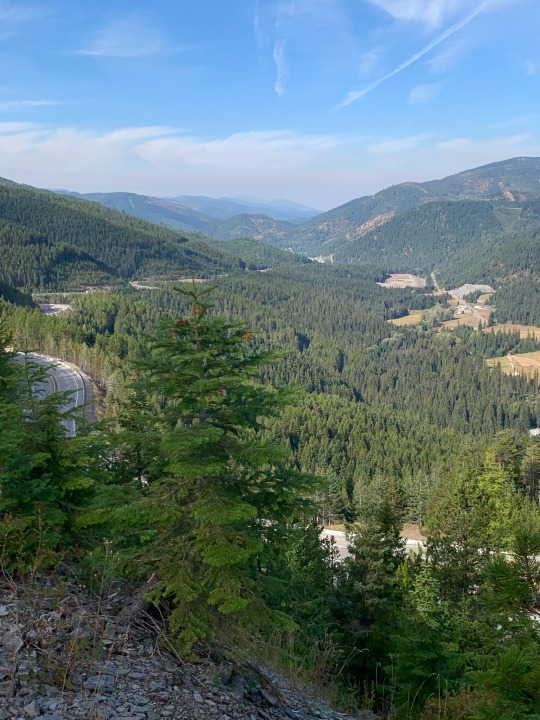
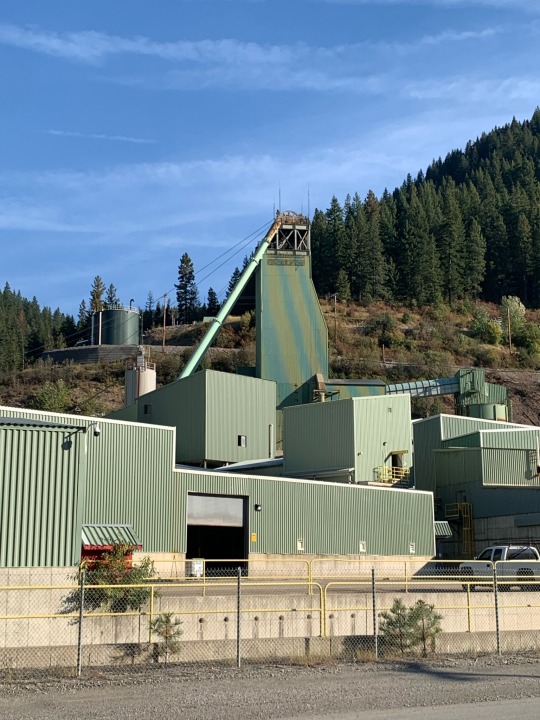
East of Mullan, I was on the road (quiet, no traffic) for several miles up past Hecla’s Lucky Friday Mine (I still have a powerful, somewhat surreal, memories of visiting lower levels of the Lucky Friday during a grad school field trip in the 80s). In Shoshone Park, I picked up the Northern Pacific (NorPac) Trail, which follows the old railroad grade up and over Lookout Pass (4700’) into Montana. The NorPac then continues down the east side, crossing under I-90 a couple of times (there’s a short cutoff to bypass the closed Borax tunnel), and emerges at Taft (once one of the nastiest mining towns in the west, but now just a highway maintenance yard on the interstate).
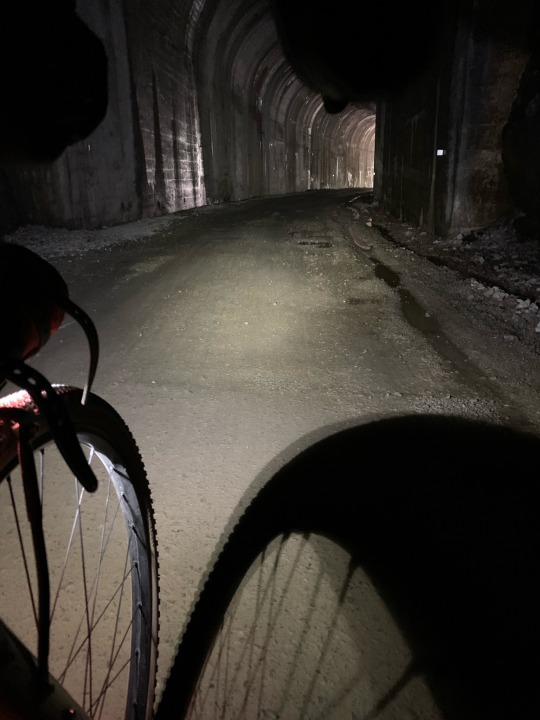

It was a short climb up to the west portal of the 1.7 mile long Taft tunnel. This is where bike tourists typically start their downhill ride on the Route of the Hiawatha (and get shuttled back up). The official season ended in mid-September and the trail was gated, but there were no other explanatory or warning signs, so I went on through (my option was the steep gravel climb up over Roland (St. Paul) Pass, so I was glad for the shortcut through the divide). Once through, I was back in Idaho again, so my time in the mountain time zone was pretty brief.
The Route of the Hiawatha generally refers to the old Milwaukee Road, on which the elegant Olympian Hiawatha passenger train used to run, but here the name refers specifically to the section of rail trail from the Taft Tunnel down to Pearson. A month earlier and the trail would have been full of tourists on bikes enjoying the trestles and tunnels, but today I had it almost to myself.

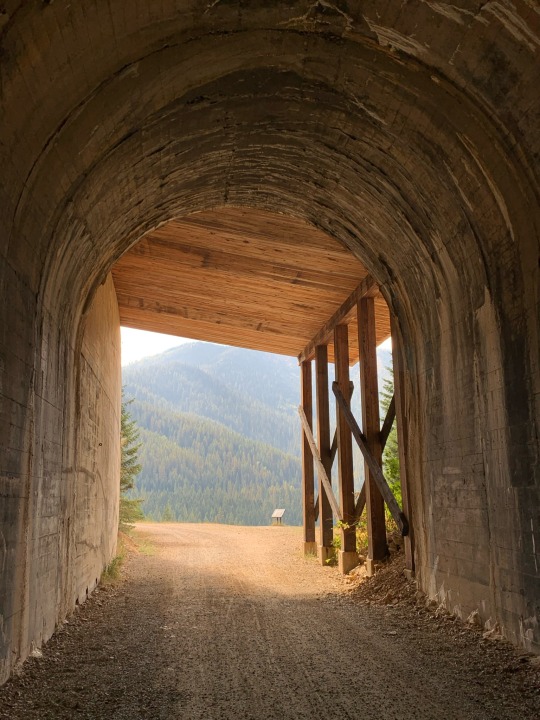
From Pearson, it was another 10 miles down the North Fork of the St. Joe to Avery. The railroad grade is now used as the road (still gravel) but there is also a less traveled route on the opposite bank of the river which is what I took. The two switch sides about half way down.
In Avery, I picked up snacks at the small store and a deli sandwich for dinner from Dan at the fly fishing shop across the street, which I ate in my room at the old schoolhouse.
*Short aside on Wallace.
Wallace has done a good job of preserving and capitalizing on its rich history - to the point where it’s preservation has become an important part of its history. The town is primarily about silver mining - begun in the late 1800s and still continuing today. The mining brought business, and vice, and railroads. Wallace (and Taft and Avery) were at the center of the terrible forest fires of 1910 (captured in Timothy Egan’s The Big Burn). In 1972, Wallace was the site of the Sunshine Mine fire, which took almost 100 lives, which I heard about on the news as a kid. But I also remember hearing Charles Kuralt’s episode on CBS Evening News sometime in the mid-1970s highlighting Wallace’s battle over the completion of the final segment of Interstate 90, which threatened to go straight through town (the result of the town being built in a narrow steep valley on the main road between Boston, Chicago, and Seattle). The compromise is that the highway now passes over the north edge of town on a viaduct. Wallace, and the entire Silver Valley (Kellogg and Silver Mountain), have had to deal with the legacy of silver mining as well as the double-edged legacy of federal efforts to clean up the mess it left behind.
Finally, for the last couple of decades Wallace has been the Center of the Universe - they even have a manhole cover to prove it. Wallace also has a Prime Minister. It was PM Rick, who plays many roles in Wallace, who responded to my emails about conditions on the bike route and told me where I could park my car while I was riding.
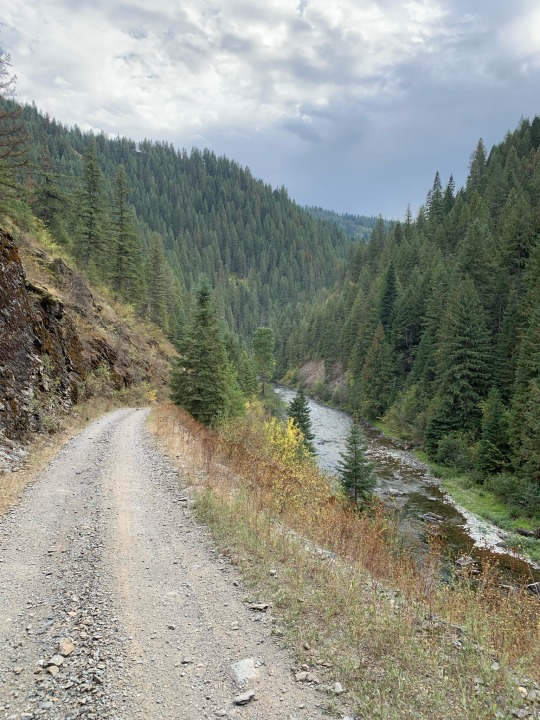

1 note
·
View note
Video
Milw 16 Feb. 69 2 by Joseph Petric
Via Flickr:
Power from Milwaukee Road train #16, pretty well iced up from bad weather across South Dakota and Minnesota, December 1969.
#olympian hiawatha#milw#milwaukee road#1969#minneapolis#aberdeen#trains#passenger train#history#minneapolis milwaukee road depot#minnesota
27 notes
·
View notes
Photo

Postcard view of the Milwaukee Road's "Olympian Hiawatha" in the Cascade Mountains. The distinctive Sky Dome observation car can be seen in the photo.
Image accompanies the Wikipedia article about the streamlined flagship passenger train here.
48 notes
·
View notes
Video
Shades of the Olympian Hiawatha by Jeff Terry
Via Flickr:
The Gourmet Express, operated by the Friends of 261, ran over the tracks of the Twin Cities & Western (the former Milwaukee Road main line to the west coast) on October 3, 2021. No. 261 led the train west; E9 32A led the trip east. The train departed Chanhassen at 10:00 AM and stopped on the west side of Glencoe. It then reversed directions, and stopped in Glencoe for lunch and photo runbys.
4 notes
·
View notes
Text
Week 9 - Industrial Design
Brook Stevens was an industrial designer born in Milwaukee, WI. At an early age, Stevens suffered from polio, causing his body to stiffen. Fortunately, this was one of the factors that really influenced Stevens to fight and overcome. Later being able to spend hours imagining, drawing, and crafting ideas.
By 1935, Stevens opened his first office in downtown Milwaukee. He designed logos for companies. With The Great Depression and World War II creeping around the corner, Brooks Stevens was able to take the military jeep and turn it back into something American’s would want to drive around.
Once business started booming for Stevens, he was able to partner with companies such as Miller Brewing and Harley-Davidson! His design ideas and business mindset rose as he designed the Olympian Hiawatha. This design was a train that was operated by Milwaukee Road.
Brooks Stevens decided to stay in Milwaukee because that is where business was booming! He had a great career in Milwaukee and designed so many products and logos. He even designed the Miller High Life logo, “The Champagne of Beers”!
Another classic is the Oscar Mayer Wienermobile! If you have not seen this, be sure to check it out!
2 notes
·
View notes
Text
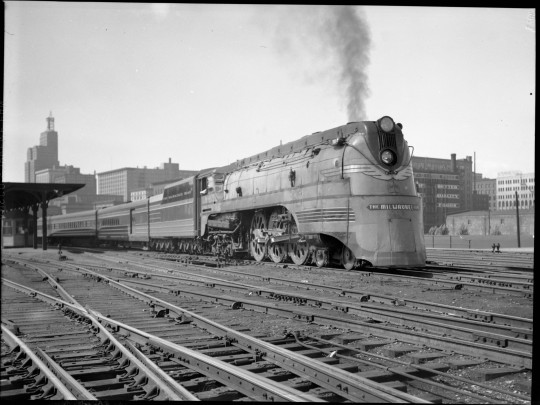
In 2019, the Hagley Library was privileged to receive a donation of over 150,000 negatives from railroad photographer and collector Herbert Harwood Jr. The following is one of a series of posts featuring images from the collection. To learn more and see additional images from the collection, check the Hagley Digital Archives.
The majority of the negatives in the Harwood collection focus on the Northeast with Amtrak, Baltimore & Ohio, Pennsylvania Railroad, and New York Central being the companies with the largest cache of images. While leaning towards the northeast it is far from a regional collection. Nearly every major railroad company in the U.S. during the 20th century some representation.
In a previous post, we looked at the B&O’s famous Royal Blue line that operated along the well traveled northeast corridor between Washington D.C. and New York City. The collection includes another regal and well-known passenger line that traveled the northwest between Chicago and Puget Sound for the Chicago, Milwaukee, St. Paul and Pacific Railway. The rail company was more commonly known as ‘The Milwaukee Road.’
The Olympian made its first trip across the continent in 1911. Under the headline “Palatial Train Pulls Into the City” the Anaconda Standard in Montana reported that the maiden trip of the line arrived in the morning and “was greeted at the station by a big crowd of people who expressed admiration for the splendid equipment of what is the finest train service ever seen in the West.”
The “Olympian” operated until 1947 when it was replaced by the “Olympian Hiawatha” a streamlined modernized version of the passenger service. Marketed as a tourist train -- see this classic promotional film from 1952 -- the line is perhaps best known for their unique Skytop observation cars designed by industrial designer Brooks Stevens (see below). Introduced in 1948, the cars were part of the Twin Cities Hiawatha that ran between Chicago and St. Paul and the long distance Olympian Hiawatha.
The Milwaukee Road’s Olympian line ceased operations in 1961 becoming one of the first of the many famed passenger lines that disappeared in the second half of the century.
Header image: Milwaukee Road streamlined Hiawatha leaving St. Paul, Minnesota, 1945
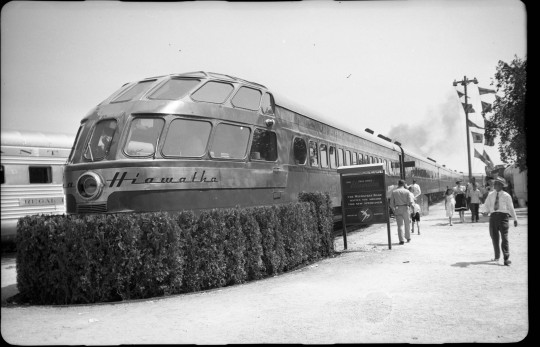
Hiawatha display at Chicago Railroad Fair, 1948 (W.D. Edson)
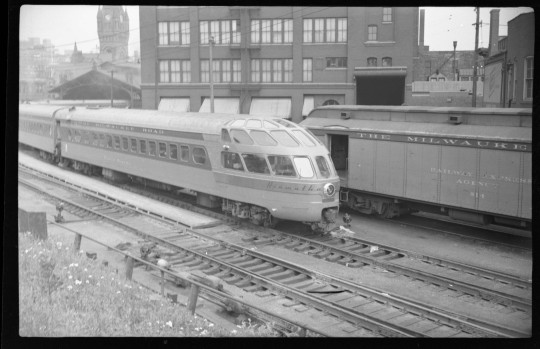
Hiawatha Skytop lounge observation car traveling eastbound through Milwaukee, Wisconsin, 1949 (William D. Slade)

Westbound Afternoon Hiawatha leaving Milwaukee, Wisconsin, 1963 (Herbert H. Harwood, Jr.)
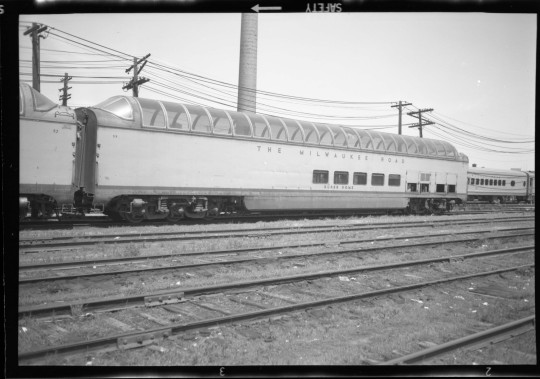
Hiawatha Super Dome observation car in Chicago, 1971 (Herbert H. Harwood Jr.)
For more information about these images and additional selections from the Milwaukee Road, check out the Harwood Collection in the Hagley Digital Archives
#Milwaukee Road#railroads#railfan#hiawatha#Super Dome car#Chicago#Milwaukee#St Paul#Skytop car#photography#black and white photography
139 notes
·
View notes
Photo
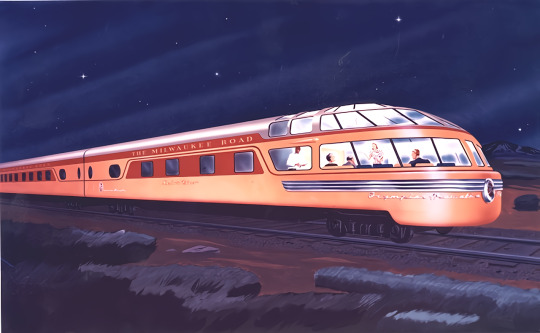



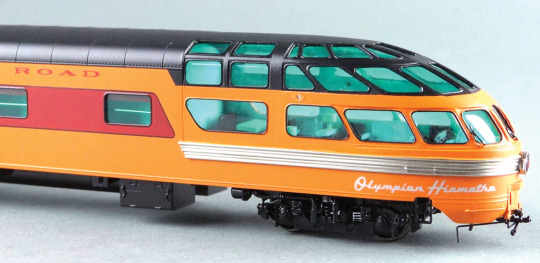


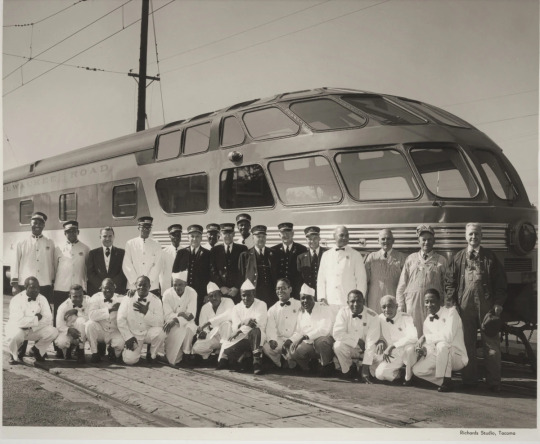

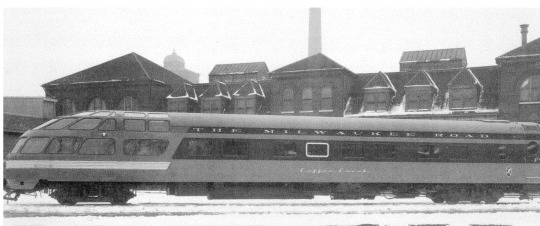
Milwaukee Road “Skytop” lounge-sleeper cars, 1948
In early 1948 the Chicago, Milwaukee, St. Paul and Pacific Railroad built four “Rapids” series lounge-parlor-observation cars in their home shops for their “Morning Hiawatha” and “Afternoon Hiawatha” passenger services, daytime trains that ran twice-daily through the Great Lakes region. Dubbed “Skytops”, these cars were designed by famed industrial designer Brooks Stevens, whose accomplishments vary from trains and automobiles to home appliances and even the original Wienermobile. These "Skytops” featured a radical design, with their tail-end an elongated quarter-sphere with a bullet-tip floor plan in a complex curvature made up of flat sections joined like a polyhedron. The cars’ tails were 90% glass and featured flat panels of glass only, no curved glass at all in their construction. The four “Rapids” series cars, which each boasted a name ending in “Rapids”, were parlor cars, with comfortable single seats which swiveled, rather than benches as in Coach, offered at First-class rates.
In late 1948 Milwaukee Road outsourced to the Pullman Company the construction of six “Skytops” for use on their long-distance “Olympian Hiawatha” service which ran between Chicago, Illinois and Seattle, Washington. Dubbed “Creek” series, with names all ending in the word “Creek”, these “Skytops”, delivered between December 1948 and January 1949, were lounge-sleeping cars rather than lounge-parlors, and featured eight bedrooms, sleeping sixteen, in the forward majority of the car, each with private toilet, plus a public toilet at the head of the car, and an enlarged lounge area seating twenty at the tail-end. Visually similar to the “Rapids” series cars in exterior, the “Creek” series lounge-sleepers had an extra bay of windows and skylights forward of the main tail section, and a different arrangement of windows along the sides of the car forward of the lounge.
During its existence the “Olympian Hiawatha” saw stiff competition from several rival trains along the same route, and the Milwaukee Road Company created bold, stylish passenger cars such as the “Skytops” and “Super Domes” in hopes of giving their service an edge. However, the 1950s saw the creation of the US Interstate Highway System and the subsequent diminishing of the railroads at the hands of an automobile boom, and with diminishing ridership and mounting losses the Milwaukee Road cancelled the “Olympian Hiawatha” in 1961. After this the six “Creek” series cars were sold to Canadian National, and served on various trains throughout the 1960s and early seventies. The cars, which had exits only at their forward ends, saw the end of service when new safety laws decreed all passenger cars in service must have at least two exits, and an exit at each end. After this Canadian National scrapped three of the cars and sold the rest to US interests. One car “Coffee Creek”, is currently under restoration, and the last two, “Gold Creek” and “Arrow Creek”, are stored as cut-up hulks at the Milwaukee Road Heritage Center.
Photos:
Image one is original concept art for the Skytop sleeper, painted by Brooks Stevens.
Image 3 is an edit of Image 2 which I personally did.
Image 4′s source is here
Image 5 is a model of the car.
Images 6–10 are historical photos from various sources.
20 notes
·
View notes
Text

Short model railroad update: I got the locomotives for the Olympian Hiawatha! An FP7A, F7B and another FP7A of the Milwaukee railroad
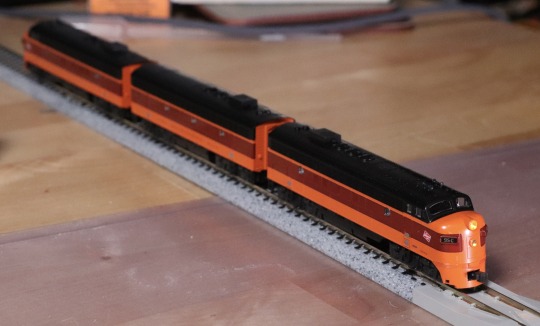
Going ABA instead of just two units does look nicer, doesn't it? I've fitted them all with DCC, using a PD10MU decoder, a basic thing for soldering in.
I've tried the Digitrax plug-and-play decoders before for other F units, and I've always been less than impressed. They're relatively expensive (two Digitrax ones would have cost more than the three I picked), not really that much less work, and I always felt like they're not super great with dirty rails. Of course in an ideal world Kato would just put a standard decoder plug in these things, but I'm not holding my breath. Instead I'm holding my soldering iron.
As for speed matching, that has not been a problem, since all three have the same decoder. And the long passenger train with the long train of locomotives in front looks really nice. The passenger train also has lights in now, but no pictures because, well, I couldn't be bothered. Maybe I'll make another post explaining the reason why I couldn't be bothered. It's to do with yet another train.
#model train#model railroad#model trains#model railroads#milwaukee#Milwaukee road#milw#emd fp7#kato#unitrack
4 notes
·
View notes
Text
Week 9
Brooks Stevens was a student at Cornell University 1929, but in 1933 he returned to Milwaukee and worked as an inventory manager. While in milwaukee, he decided to redesigned the logo of Jewett and Sherman and Cutler-Hammer’s company, which was his first stage as an industrial designer. Later, he opened his first office at 340 North Milwaukee St. Steven. Brooks Stevens’s would go on to turn the army Jeep into a station wagon, jeep and designed the Olympian Hiawatha train of Milwaukee Road. He was the only Midwestern founder of the Society of Industrial Designers and the first industrial designer to have a one-person museum retrospective.
0 notes
Text
Week 9- Industrial Design
Last week, we were to read an article about Brooks Stevens and his industrial design in Milwaukee. This article was extremely interesting and I was shocked that I hadn’t learned more about him prior. Stevens has a major part in the history of industrial design in Milwaukee. He worked with most of the major manufacturing companies in Milwaukee such as, Miller Brewing, Allen-Bradley, the Outboard Marine Company, and Harley-Davidson. He also designed a train called the Olympian- Hiawatha. During this time in his career Stevens, “Became the only Midwestern founder of the Society of Industrial Designers (SID)”(Milwaukee Art Museum). Given the talent Stevens possessed, he could have moved anywhere to design but always stayed in Milwaukee. When asked why he would stay in Milwaukee over other major cities like New York he would say, Milwaukee is where the business is.
0 notes

